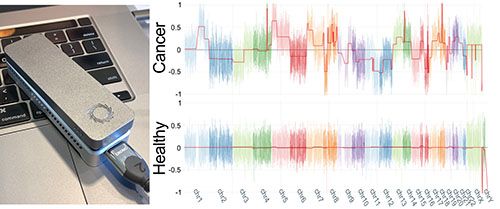18/03/2021

New method to monitor genomic alterations in cancer patients. An easier, faster and cheaper approach. The collaborative study from the Cnr Institute of Clinical Physiology, Ispro, the University of Pisa and Florence, and Aoup, has been published in Molecular Cancer
While the overall evolution of the oncological disease can be predicted using epidemiological data, its development in the individual patient derives from genetic factors and specific stochastic events that define prognosis and therapeutic options. In the quest for biomarkers that can predict the course of the disease as early as possible, the analysis of the tumor genome – where lies all information that defines it - has so far proved problematic due to the difficulty in obtaining tumor material. Thanks to the collaboration between the Institute of clinical physiology of the National research council (Cnr-Ifc), the Institute for cancer research, prevention and clinical network (Ispro), the University of Pisa (Unipi), the University of Florence (Unifi), and Pisa University Hospital (Aoup), an innovative method to monitor cancer patients has been developed using third generation sequencing. The study has been published in Molecular Cancer.
“The approach is based on liquid biopsy: it starts with a blood sample to isolate the circulating DNA - damaged DNA characterized by very small fragments- mostly resulting from the death of healthy cells. In cancer patients circulating DNA also contains material from the death of cancer cells in a percentage that depends on the state of the tumor: little amounts in primary tumors and after therapy, higher amounts when tumor growth increases, after the onset of metastasis”, explains Silvo Conticello of Cnr-Ifc and Ispro, coordinator of the study. “In the new method, after purification from patients' plasma, the circulating DNA is sequenced directly using Nanopore technology”. Nanopore technology is based on hundreds of nano-pores on a membrane, through which the DNA is pushed by artificial motor proteins. As DNA fragments pass through the pore, the individual bases (adenine, cytosine, guanine, thymine) alter an electrical signal, which is then decoded into the sequence of the individual fragments. The sequence of the fragments allows their localization on the genome, and to count their number in each specific genomic region. “By calculating their excess or defect, compared to the average, we can identify regions of the genome where alterations in the number of chromosomal copies (amplifications or deletions) are present. These alterations are associated with tumor progression: our ability to characterize the tumor can give indications for the individual patient -in a context of personalized medicine- to better classify the tumor and to monitor it over time, in order to choose the most suitable treatment”, continues Conticello. “Our approach can represent a solution to various problems, for the ease with which the method can be performed, for the short time required to perform the analysis, and for the reduction of the costs necessary to set it up (a Nanopore sequencer costs about €1000, rather less than other sequencers, whose price starts at €80,000)”.
“Using a user-friendly protocol, this method will finally allow to bring the genomic analysis into clinical practice and to carry it out even in the smallest hospitals”, confirms Filippo Martignano of Ispro, who conceived the study, in collaboration with the research units led Alberto Magi from Unifi, Marzia Del Re from Unipi and Iacopo Petrini from the Pisa University Hospital (Aoup). “It will also be possible to access the epigenetic information -the set of modifications that cells -including cancer ones- add to DNA to activate or deactivate parts of the genome. This information, crossed with that regarding chromosomal alterations, will enable physicians to obtain an even better characterization of the tumor”.
Rome, 18 March 2021
The figure shows a Nanopore sequencer (left) and the genomic profile (right) of samples obtained from a cancer patient (above) and from a healthy donor (below). The red line indicates the number of copies for each chromosome: values above zero indicate the amplification of a given chromosomal region, the ones below indicate the loss of portions of a chromosome.
In brief:
Who: Institute of Clinical Physiology of the National Research Council (Cnr-Ifc); Institute for cancer research, prevention and clinical network (Ispro); Department of Information Engineering of the University of Florence; Pneumology Unit at the University Hospital of Pisa; Department of Clinical and Experimental Medicine of the University of Pisa.
What: on a method to monitor cancer patients: Molecular Cancer: “Nanopore sequencing from liquid biopsy: analysis of copy number variations from cell-free DNA of lung cancer patients”; Filippo Martignano, Uday Munagala, Stefania Crucitta, Alessandra Mingrino, Roberto Semeraro, Marzia Del Re, Iacopo Petrini, Alberto Magi, and Silvestro G. Conticello. Molecular Cancer 20:32 (2021) (https://molecular-cancer.biomedcentral.com/articles/10.1186/s12943-021-01327-5).
For information: Silvo Conticello, Cnr-Institute of Clinical Physiology (Cnr-Ifc); Core research laboratory – Ispro, silvestro.conticello@cnr.it, tel. + 39 0557944565; Communication office Cnr-Ifc, email: comunicazione@ifc.cnr.it, tel. + 39 0503152616
Ufficio stampa:
Cecilia Migali
Ufficio stampa Cnr - Roma
cecilia.migali@cnr.it
Responsabile Unità Ufficio stampa:
Marco Ferrazzoli
marco.ferrazzoli@cnr.it
ufficiostampa@cnr.it
06 4993 3383
